 |
|
|
  
Demonstration no.: 113 Description: A long string (for example 1.5 meters) is tied to the handle of a porcelain coffee cup. In the other end of the string, a light object like a paper clip is tied. The string is put over a pencil which is held in an out-stretched arm. The paper clip is held in the other hand, so that the coffee cup is hanging freely beneath the pencil. 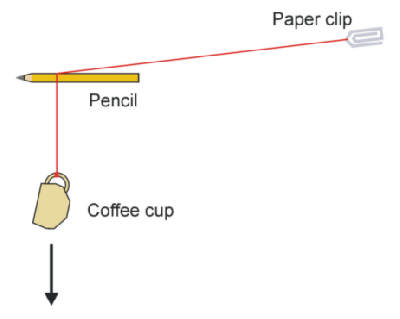
A coffee cup is suspended from a string lying over a pencil. In the other end, a paper clip is tied. When the clip is released, the cup falls towards the ground. It is, however, stopped before hitting the ground by the string which rotates around the pencil.
You now tell the audience that you intend to let go of the paper clip, making it possible for the rope to slide freely over the pencil while the cup falls towards the ground. If you ask the audience what will happen, the answer will typically be that the cup will fall to the ground and shatter. You then let go of the paper clip. 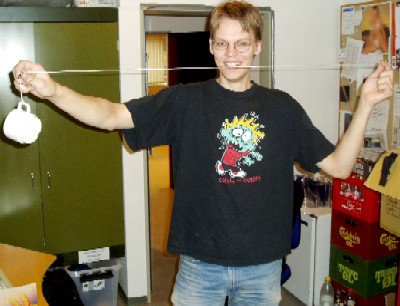
A coffee cup is suspended from a string hanging over a pencil. In the other end, a small metal screw is attached instead of a paper clip.
The cup now falls towards the ground, but before it impacts, it is stopped by the string. 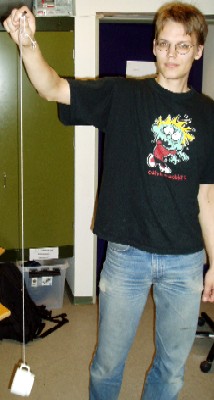
The coffee cup is stopped by the string which has wound itself around the pencil.
The string will wind itself several times around the pencil, thus stopping the fall of the cup. When the paper clip is released, it will also start to fall towards the ground. Since the string is lying above the pencil, the paper clip will effectively start to rotate around this. Since the string becomes shorter and shorter, the rotation will become faster and faster due to conservation of angular momentum. The result is that the string will wind itself very thightly around the pencil. The demonstration can be seen in the movie listed in the references. 
Excerpt from the movie in the references, where the demonstration is performed.
The demonstration can also be done on a larger scale. Here, the cup is replaced by a bowling ball, the string by a rope, and the paper clip by a roll of duct tape. The pencil is replaced by a thick metal pipe: 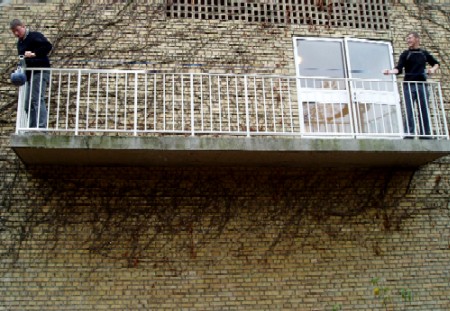
A rope is attached to a bowling ball. The rope goes over an aluminum pipe and in the other end a roll of duct tape is attached.
After the fall, the bowling ball stops right above the ground: 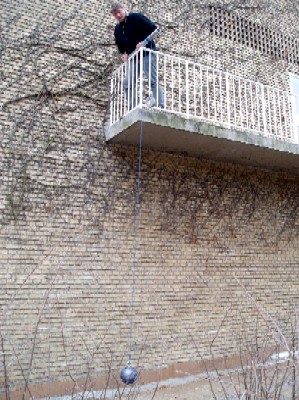
The bowling ball has stopped just above the ground, because the rope has wound itself around the metal pipe.
The rope has wound itself around the metal pipe, thereby stopping the fall of the bowling ball. 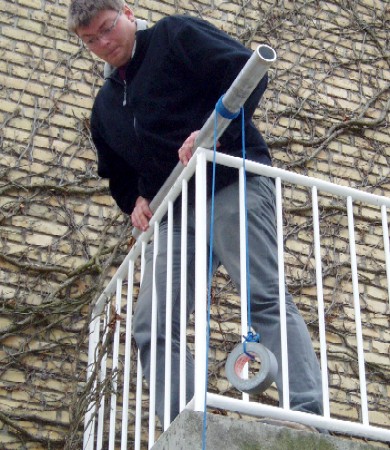
Close-up of the roll of duct tape and the rope around the metal pipe.
Take a look at the video in the references. Equipment and materials:
References:
PIRA DCS: 1Q40.00 (Mechanics: Rotational dynamics) Updated: 5 November 2007 If you have comments, corrections or suggestions regarding this demonstration, |
| FYSIKBASEN.DK was updated on Sunday, 16 June 2008, at 23:01. |
 Angular momentum brake for falling coffee cup
Angular momentum brake for falling coffee cup String
String